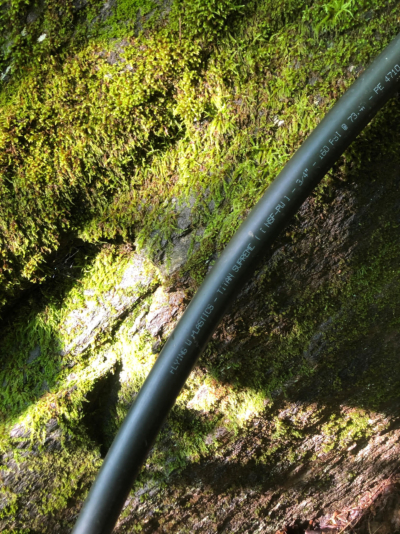I’ve mentioned that our new prepper property has a gravity-fed water supply is that it provides water even when the electricity is out. Here’s the promised article on how it works.
Most rural properties, including the last two I have lived in, use wells for their water. When the power goes out, the pump doesn’t work unless you have solar or a generator. With gravity-fed water, we get full-power, high-quality, clean drinking water from a system that requires no electricity and uses no pressure tank or other moving parts that can wear our or break.
We can do this because our prepper property on about 20 acres on the side of a mountain and by getting water from a source uphill from the house, it can be delivered to the home via gravity.
A couple hundred feet up the mountain is a spring that has been developed to provide our house with running water. While it does not provide a huge amount of water at one time, it’s never been known to run dry.
As part of our due diligence, I spoke to the gentleman who developed the spring. That’s a big part of his business, and he was happy to explain how it works.
How to Develop a Spring
To develop a spring, you need to find one on your property. The best time to look is in the dry season. That way, you can be assured it won’t run dry during periods without rain.
Our spring was originally a seep, where water seeps out of the ground across several feet rather than bubbling forth in a single stream. To develop it, they dug out the area around the seep and dug it back into the hill until they found where the source of the water “sprang” out of the rock. This area was then dug out down to the bedrock.
A large cement barrier or dam was poured in place to capture the water. Two pipes were installed through the wall of the dam. The lower pipe was the feed pipe, the source of the water for our house. The upper pipe was the overflow which lets excess water come out. If too much water builds up behind your dam, it would run around the top or sides, and you don’t want that. It’s also important that the overflow has a screen to keep bugs and small animals out when it is not in use.
After the cement dried and the water was settled and clear, the dam was backfilled with gravel from a stream or river bed. Then several layers of a heavy plastic sheet were laid over the new spring box in a manner designed to keep out rain and any runoff from the hill above out of the spring. The piled dirt and then rocks on top of this to hold it down. By the time I saw it, it was overgrown and looked natural with the exception of two pipe sticking out of the side of a hill.
The Cistern or Well Tank

The output from the spring runs through a black polyethylene pipe for about 800 feet down the mountain to a cistern or underground water tank. Now by 800 feet, I mean the black pipe or hose it runs through is more than 800 feet long, I don’t mean it is a 800 foot vertical drop. It traverses across a good part of the mountain horizontally. How do I know it’s more than 800 feet? Because the installer used 400-foot rolls and I have seen where they are spliced together.
The output from the spring runs through a black polyethylene pipe for about 800 feet down the mountain to a cistern or underground water tank. Now by 800 feet, I mean the black pipe or hose it runs through is more than 800 feet long, I don’t mean it is a 800 foot vertical drop. It traverses a good part of the mountain horizontally. How do I know it’s more than 800 feet? Because the installer used 400-foot rolls and you can see where they are spliced together.
This hose runs down the mountain, mostly alongside an old logging road, until it reaches a buried 800-gallon storage tank.
Water Usage
On a normal day, the spring produces about 2 gallons of water per minute. That is 2,880 gallons of water a day. Because we use only a fraction of that amount, there is an overflow pipe and water that runs out of the tank goes on down the hill until it joins up with one of the other streams on the property. (There are several.)
The government estimates that the average person uses 80 to 100 gallons of water a day – including flushing, bathing, food prep, doing laundry and washing dishes – so even if there were 10 people squeezed into the house, 2,880 gallons should be more than enough. Even if the flow dropped to one gallon per minute, it would be sufficient.
Most of the water that is “used” in our house is eventually returned to nature as it runs down the drain and down the toilet and into the septic tank and the septic field where it is absorbed into the ground. So you could say we are simply borrowing the water.
Building Water Pressure
This storage tank is positioned about 140 vertical feet above the house. The water in the tank runs down a buried pipe that feed directly into the house at 63 PSI, which is more than adequate pressure. The faucets and showers have good water pressure.
You will note that the pipe below the tank is buried while the pipe above the tanks is not. This is because the pipe between the spring and the tank has water flowing through it at all times, and as such will not freeze. The water in the tank and below is used only when someone opens a faucet or flushes a toilet. It may sit there for hours. That means it must be buried to keep it from freezing
Why we Need the Cistern
When we wake up in the morning, the tank above us has filled up overnight and the new water simply runs out the overflow pipe and down the hill into the stream. What’s the first thing you do when you wake up? Flush the toilet, take a shower, maybe brush your teeth? Let’s assume that my wife and I do all that in twenty minutes and use 60 gallons of water.
Because the tank gets refreshed at a rate of only 2 gallons per minute, in those 20 minutes, we will have used 60 gallons and replenished only 40. That’s why a storage tank is necessary. The spring is providing a constant slow flow of water but we use it in bigger spurts. The spring catches up eventually. In this case, in just another 10 minutes it will have replenished all the water and the excess water will start to flow out the overflow hose again.
Now let’s say we water the garden one afternoon. It’s been a dry week and we are using a sprinkler, so it takes 200 gallons of water. At the same time, we clean and hose out the chicken coop. Inside, a load of laundry is running. So in an hour, we use 260 gallons of water. The spring is only providing 120 gallons of water per hour. Because the tank holds so much, we don’t realize that we are using more water than the spring produces. In just over an hour, the tank will fill back up. With the tank, we could use that much water for five hours and still not run out. But even if the tank were to be used up, when we woke up the next morning, it would be full again and we could start the cycle all over.
How Springs Work
I have to admit, I am kind of amazed that water chooses to seep, gurgle, or sometimes shoot out the side of a mountain. In our case, it’s more than three quarters of the way to the top. Why is the spring near the top instead of at the bottom? Shouldn’t the water flow out the bottom? Is there some secret pressure pushing water up and out?
Admittedly, I am not a geologist, but the reason springs happens fairly high up the mountain apparently has to do with changes in the type of rock that make up the mountain itself. From what I understand, rain that falls on the mountain is absorbed by the surface dirt and continues to follow gravity as it is pulled into and through the porous rock under the dirt, such as sandstone or schist. Eventually, it hits a layer of harder rock. Because water cannot penetrate this non-porous layer, it accumulates in pools, pockets, cracks and crevices and when they fill up, it flows to a low point and runs out and onto the surface as a spring.
We live in an area that gets plenty of rain. That’s why there are springs all up and down the local mountains. In fact, of all our neighbors, I only know one that uses a traditional well. Everyone else has spring water
Water Quality
Because the mountain top is undeveloped wilderness with no roads and has never been farmed in the modern era, the spring water is very clean and pure with a pH or 7.4 (a bit alkaline, but well inside the normal range for drinking water). There’s no E. coli bacteria, lead, nitrates, iron, chlorine or fluoride in the water. It has not been contaminated by animal waste, human waste, chemicals, fertilizer, road salt, oil, or other man-made contaminants. Most importantly, it tastes great! (Our spring is considered a “sweet” spring because the water does not contain excessive minerals that affect its taste.)
Don’t assume that spring water is always safe as even springs in wilderness areas might have giardia, cryptosporidium, bacteria, or other contaminants that could cause infection and illness. If your water source is a spring, many mortgage lenders will want you to install a UV water treatment system. This is to destroy any coliform (bacteria) that might be in the water. Testing revealed that we did not need to do this. If I was raising babies or caring for people with immune deficiencies, I might consider installing one, just to be extra safe, because spring water quality can and does change based on a number of variables.
Great for Preppers
I’ve lived in houses with wells and we needed filters and other water treatments to remove particulate, iron and soften hard water. Here, we do not. The spring water does not turn white clothes and sheets yellow, it does not leave a rusty or blue-green ring on toilet bowls or build up scale on faucets. Our glasses come out clear, and we no longer need a bottle of CLR when it’s time to clean the bathroom.
That’s all nice, but in a post TEOTWAWKI situation, having running water will be even better! That’s what makes a gravity-fed water system so great fro preppers.








